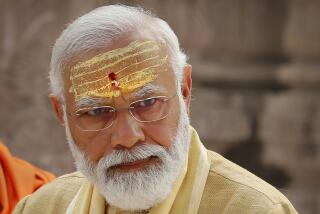North Korea agrees to let in nuclear inspectors
North Korea agreed Saturday to finish dismantling its main atomic reactor by the end of October and allow international inspectors to visit its nuclear facilities in a deal that inched the tortuous negotiations forward but was short on specifics.
The agreement, hashed out at the end of another round of international talks here in China, does not say how the denuclearization process would be verified, and it does not include plans for full disarmament. But it’s another step forward in the long process of getting the secretive communist regime to give up its nuclear program.
To that end, Pyongyang broadly agreed to permit outside inspectors, including members of the International Atomic Energy Agency, in exchange for fuel and other economic aid.
U.S. Assistant Secretary of State Christopher Hill said he expected the details of the verification process to be worked out by early September.
“We would like the protocol to be reached within 45 days and, secondly, to begin verification within 45 days,” Hill told reporters after the three-day meeting of six nations ended in Beijing. “We’re anticipating that, and we don’t see any obstacles.”
Given how frustrating negotiations with Pyongyang have been in the past, the endgame may not be as near as it seems. Observers say the Bush administration wants to accentuate the positive because it is running out of time and eager to show results. The North Koreans know that and may have used it to extract more concessions and buy themselves more time until Americans elect a new president. Other nations involved in the talks are Japan, Russia and South Korea.
“This is progress,” said Joseph Cheng, a professor at the City University of Hong Kong. “But Pyongyang is a very tough negotiator. It is always trying to squeeze for more. Given the fact that the Bush administration is a lame-duck administration, real significant progress may yet have to wait.”
Among the unresolved issues are how much of North Korea’s actual stockpile was disclosed last month when it made its nuclear weapons declaration to the world, and how much real access it is willing to give the inspectors. No details were given on the uranium enrichment program that the U.S. believes Pyongyang is running in addition to its plutonium one.
Despite these omissions, Washington took Pyongyang off the list of states sponsoring terrorism and relaxed some economic sanctions. The North Koreans then blew up the cooling tower for the main reactor at the Yongbyon nuclear complex. The symbolic gesture helped pave the way for resuming the talks, which had been suspended for about nine months.
After Saturday’s agreement, the impoverished North Koreans once again walked away with promises of more energy aid. Other pledges of help from China and South Korea are on the way.
--
More to Read
Start your day right
Sign up for Essential California for news, features and recommendations from the L.A. Times and beyond in your inbox six days a week.
You may occasionally receive promotional content from the Los Angeles Times.






